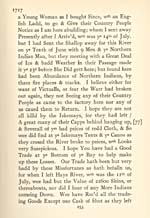|
|
KNIGHT, STUART AND THANADELTHUR, THE NATIVE WOMAN GUIDEJames Knight (c. 1640 - c. 1720)
|
||||||||||||
 "Plans of York and Prince of Wales's Forts" Copyright/Source |
Thanadelthur, a Chipewyan, and two other young women were captured by the Cree in a 1713 attack on a band of their nation. Thanadelthur managed to escape with one of her friends but cold and hunger prevented them from reaching their home territory and brought the other young woman's death. Thanadelthur found her way to Fort York on November 24, 1714, thanks to employees of the Hudson's Bay Company, whom she met on the way. She explained to the governor of the fort, James Knight, that the unarmed Chipewyan people could not come to Hudson's Bay for trade because the Cree, who had guns, were waging war against them. She also told Knight of a mine of yellow metal in the northwest, beyond the Churchill River. This information piqued Knight's curiosity. He immediately organized an expedition and assigned William Stuart, a Company employee, to lead it beyond Cree territory, guided by Thanadelthur.
On June 27, 1715, Stuart, Thanadelthur and 150 Cree left Fort York with the various intentions of re-establishing peace between the Cree and the Chipewyan, bringing back some northern Native people to Fort York, announcing the construction of a fort at Churchill River, and looking for minerals. At Governor Knight's express request, Stuart was, above all, to protect the "slave woman". Cold and lack of food soon dispersed the travellers. After having painfully crossed the tundra at the edge of the Boreal forest, they found five Chipewyans, killed by Cree, at the edge of a forest. Stuart and Thanadelthur knew that these murders would compromise the nations' reconciliation and the remaining expedition members were ready to turn back. Thanadelthur persuaded them to wait ten days while she, alone, went to get the Chipewyan. She came back at the last minute and managed to bring peace between the sides through lengthy negotiations.
Stuart returned in May 1716 with Thanadelthur and ten Chipewyans. He was very ill, and since he had produced no journal or map, was unable to say where they had been. He had accomplished part of his mission thanks to the young woman, but the English were disappointed because the copper they saw in the Native people's knives apparently came from a mine further west.
Finding it impossible to return to their own land that same year, the Chipewyan stayed at Fort York. Thanadelthur told Knight of the rich furs and metals of her land. Her verve and determination fuelled Knight's dreams of discoveries and he was much more taken by the girl's stories than by Stuart's, who reported having travelled 1 500 kilometres and reaching 67º N in inhospitable country. Thanadelthur encouraged Knight to plan new expeditions but herself fell ill and died on February 7, 1717.
Knight and Stuart were very much impressed by this amazing woman to whom they owed the peace agreement between the Cree and Chipewyan peoples. Knight said of her: "She was one of a very high Spirit and of the Firmest Resolution that every I see in any Body in my Days and of great Courage."
Convinced of the importance of using women as interpreters for dealing with the Chipewyan, Knight bought another First Nations woman as a slave for 60 pelts in merchandise and sent her to the Chipewyan with Richard Norton in July 1717. Stuart remained on the bay, where he fell into dementia and died two years later, in October 1719. William Stuart's renown stems from his having been the first European to cross the tundra and to visit the areas near Great Slave Lake.
 |
 |
 |
|
| Title page of Knight's published journal of 1717 Copyright/Source |
Pages from Knight's published journal of 1717 Copyright/Source |
||
|
"I am now building of a factory at Churchill River to try whether I can gett this trade after all these Dissapointments, & have now Sent the Surviveing Northern Mann & a Young Woman as I bought Since, wth an English Ladd, to go & Give their Country People Notice as I am here abuilding; ..." (Kenney 1932, 152-153) |
James Knight returned to England in 1718 and convinced the Company of the relevance of a new expedition to the north. On June 4, 1719, he left Gravesend with two ships, the Albanyand the Discovery, to conduct explorations north of 64°, looking for the mythical Strait of Anian, which could lead them to a northwest passage. He also proposed to expand the company's trade, to establish industrial whaling stations and to look for gold and copper mines. Knight never returned from this voyage. In 1721, during an expedition, the explorer Henry Kelsey learned that the Albany had sunk. The following year, a man sent to look for him claimed, on his return, that both ships had sunk and that all the men had been killed by the Inuit.
During an exploration in 1769, Samuel Hearne found the wrecks of the two ships and the ruins of a shelter in a cove on Marble Island. The Inuit informed him, contrary to the earlier account, that some 50 men had built a house in late fall of 1719 after their ships had sunk. The following spring, their numbers had been greatly reduced and, after the second winter, they were but 20. Five of them managed to survive another winter but they were all dead by the summer of 1721. Knight's expedition put an end to the search for a passage by sea to Asia through Hudson's Bay.